There was always one dish that made my Aunt Vangie's eyes light up whenever she visited from Manila: our family's Camaron Rebosado.
I can still picture her sitting at our worn wooden dining table, dunking those perfectly crispy shrimp in sweet and sour sauce while sharing stories about her week.
What started as my Lola's special occasion dish has become our family's most requested recipe. And after years of watching her perfect this in our tiny kitchen, I've learned all the secrets to achieving that light, crispy coating that shatters with each bite, revealing the juiciest shrimp inside.
While fancy restaurants serve their own versions, nothing beats the satisfaction of creating this Filipino-Chinese favorite at home.
This recipe captures the exact technique that has made our family's Camaron Rebosado legendary in our barangay, and I'm excited to share it with you today.
What Is Camaron Rebosado?
Camaron Rebosado is a Filipino-Chinese fusion dish featuring large shrimp coated in a light, crispy batter and deep-fried until golden brown. The name combines the Spanish words "camarón" (shrimp) and "rebosar" (battered), though the cooking technique draws from Chinese culinary influence. This appetizer or main dish is distinguished by its delicate, airy coating achieved through chilled ingredients and precise temperature control during frying, resulting in perfectly crisp exteriors that give way to juicy, tender shrimp within.
Jump to:
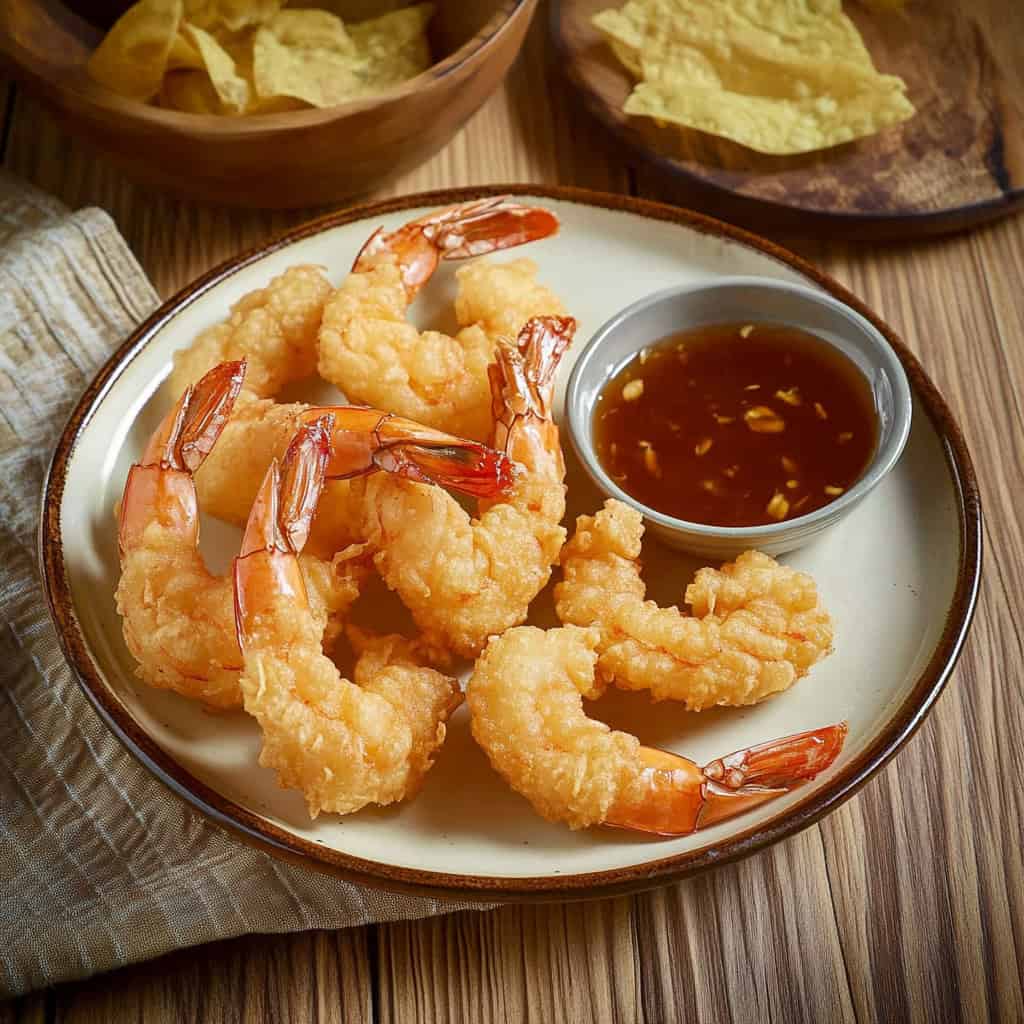
Why You'll Love This Recipe
- Perfectly crispy exterior with juicy, tender shrimp inside
- Restaurant-quality results at home
- Make-ahead friendly marinade
- Versatile serving options
- Great for both special occasions and family meals
- Impressive presentation with minimal effort
Ingredients
The ingredients in this Camaron Rebosado recipe create the perfect crispy-juicy contrast that makes this dish special. Large shrimp provide a sweet, tender base while calamansi adds brightness to cut through richness.
The secret to that signature crunch is the combination of flour and cornstarch: flour for structure, cornstarch for that airy, delicate texture. Baking powder creates tiny air bubbles in the batter, resulting in extra crispiness. Using ice-cold water and chilled ingredients slows down gluten formation and maximizes crunch when hitting the hot oil.
The final cornstarch dusting before battering creates a dry surface that helps the batter adhere perfectly, ensuring each bite delivers that satisfying shatter-crisp coating that protects the juicy shrimp inside.
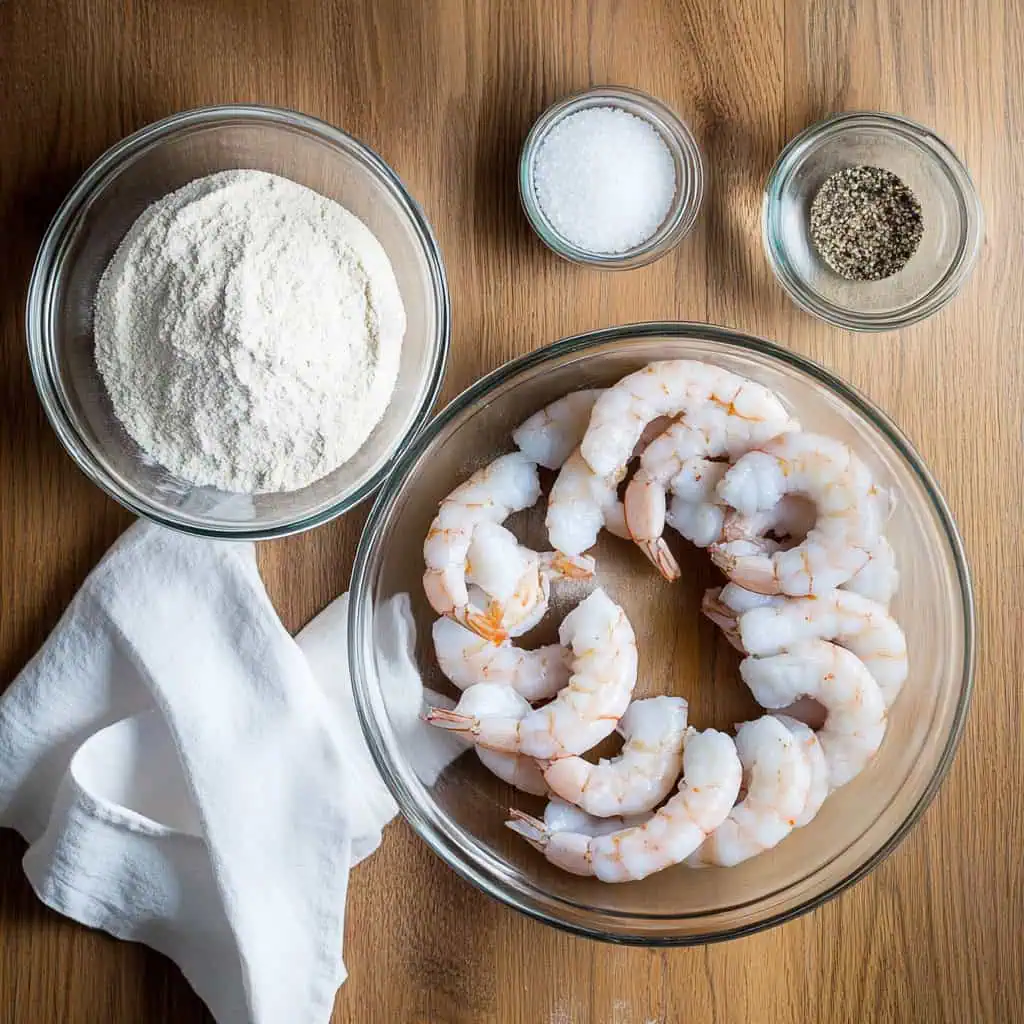
For the Shrimp:
- 1 pound (16-20 pieces) large shrimp
- 1 teaspoon calamansi or lemon juice
- ½ teaspoon salt
- ¼ teaspoon ground black pepper
For the Batter:
- ½ cup all-purpose flour
- ½ cup cornstarch
- 1 teaspoon baking powder
- 1 teaspoon salt
- ½ teaspoon white pepper
- 1 large egg, cold
- ½ cup ice-cold water
- 1 tablespoon sesame oil (optional)
For Coating:
- ¼ cup cornstarch for dusting
For Frying:
- 4 cups canola or vegetable oil
Equipment
- Deep heavy-bottomed pot or wok - Provides even heat distribution during frying, preventing hot spots that can burn the batter
- Candy/oil thermometer - Ensures perfect oil temperature for the crispiest results; temperature control is crucial for this recipe
- Spider strainer - The wide, shallow mesh design allows you to safely remove multiple shrimp at once while letting excess oil drain
- Wire rack - Placed over a baking sheet, this allows excess oil to drip away while keeping the shrimp crispy on all sides
- Mixing bowls - You'll need separate bowls for the marinade, batter, and coating for an organized workflow
- Paper towels - Used for patting the shrimp dry before coating and for absorbing excess oil if needed
- Kitchen scissors - Makes deveining shrimp easier and more precise than using a knife
- Sharp knife - For butterflying the shrimp if desired for a more attractive presentation
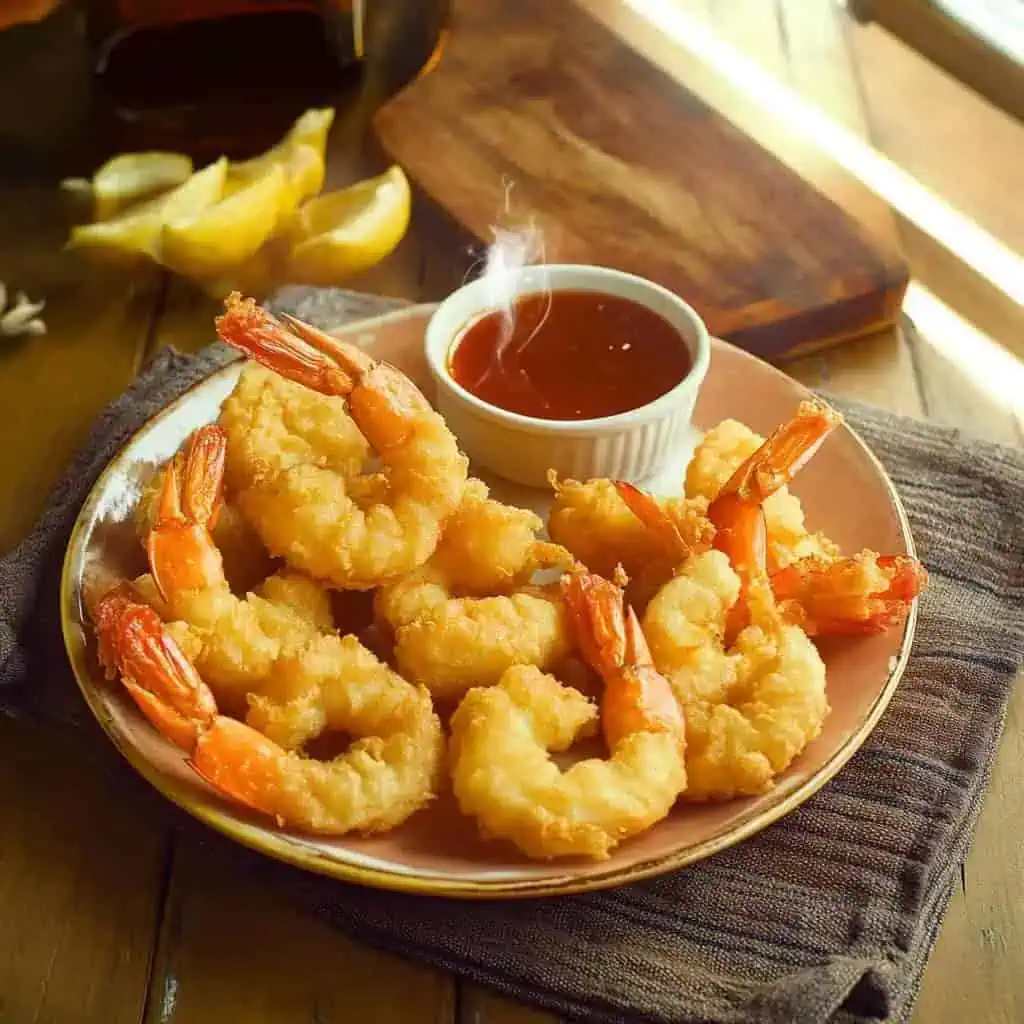
How To Make
- Prepare your shrimp. Remove the heads but keep the tails on. Cut a line down the back of each shrimp and remove the dark vein. Make three small cuts on the belly side to prevent curling. Pat the shrimp completely dry with paper towels.
- Marinate the shrimp. Mix the cleaned shrimp with calamansi juice (or lemon), salt, and pepper in a bowl. Cover and refrigerate for 10 minutes.
- Prepare the dry batter mixture. Sift together flour, cornstarch, baking powder, salt, and white pepper in a large bowl. Put this dry mixture in the refrigerator for 30 minutes - cold ingredients are the secret to crispy coating.
- Heat the oil. Heat your oil in a deep pot or wok. You'll need about 3 inches of oil, heated to 350°F. If you don't have a thermometer, test by dropping a small bit of batter - it should sizzle and float immediately.
- Make the batter. Take your flour mixture out of the fridge. In a separate bowl, mix the cold egg with ice-cold water. Pour this into your chilled flour mixture and stir gently just until combined. Don't worry about small lumps - they're good for crispiness.
- Coat the shrimp. Put some cornstarch on a plate. Take each marinated shrimp, coat it in cornstarch, shake off the excess, then dip in your batter. Hold it by the tail and let extra batter drip off.
- Fry the shrimp. Carefully place each battered shrimp in the hot oil. Don't crowd the pot - fry only 4-5 pieces at a time. Cook for 2-3 minutes until golden brown.
- Drain properly. Lift out the crispy shrimp with a strainer and place them on a wire rack, not paper towels - this keeps them crispy. Let the oil return to 350°F before cooking the next batch.
- Serve immediately. Serve your Camaron Rebosado while hot and crispy. Arrange on a platter with sweet and sour sauce, banana ketchup, or sweet chili sauce for dipping.
Remember: These are best eaten right away while the coating is perfectly crispy and the shrimp is piping hot. If you need to keep them warm, place in a 200°F oven for no more than 30 minutes.

Tips from Lola's Kitchen
- Cold is key! Refrigerate all batter ingredients for at least 30 minutes before mixing. The temperature difference between cold batter and hot oil creates the crispiest coating.
- Use filtered water turned to ice for the batter – the purer the water, the crispier the result.
- Don't discard the shrimp heads – freeze them to make a rich seafood stock for soups or palabok sauce later.
- The cornstarch dusting step is non-negotiable – it creates a barrier that helps the batter adhere perfectly to the shrimp.
- Rest your batter for 5 minutes after mixing to allow the gluten to relax, resulting in a lighter coating.
- Fry in small batches even if it takes longer – overcrowding causes temperature drops that result in oily, soggy coating.
- Check oil temperature between each batch – consistent heat is crucial for even cooking and crispiness.
- Use the "bounce test" – properly cooked Camaron Rebosado should slightly bounce when dropped from a small height onto a plate.
Substitutions
- No large shrimp? Medium prawns work well, just adjust cooking time down by 30 seconds.
- No calamansi? Equal parts lemon and lime juice creates a similar flavor profile.
- Gluten-free option: Replace all-purpose flour with rice flour for an even crispier result.
- No cornstarch? Potato starch works as a 1:1 replacement with similar results.
- Healthier oil options: Avocado oil or peanut oil both have high smoke points suitable for deep frying.
- Egg allergies? Try carbonated water alone (no egg) for a lighter tempura-style batter.
- Low-sodium diet? Reduce salt and add ½ teaspoon of garlic powder to the batter for flavor.
Troubleshooting
- Batter falling off? Your shrimp might still be too wet. Pat completely dry and make sure to dust with cornstarch before dipping in batter.
- Shrimp curling too much? Make deeper cuts on the belly side or butterfly them for a straighter presentation.
- Oily result? Your oil temperature was too low. Maintain a consistent 350°F and avoid overcrowding the pan.
- Dark coating but undercooked shrimp? Oil temperature too high. Reduce heat and use slightly larger shrimp next time.
- Batter too thick? Add 1-2 tablespoons of cold water to thin it out. The consistency should coat the back of a spoon but drip off easily.
- Rubbery shrimp? You've overcooked them. Reduce frying time and remove as soon as the batter turns golden.
- Soggy coating minutes after frying? Place on a wire rack instead of paper towels and ensure proper oil temperature throughout cooking.
Storage & Reheating
Storage:
- Refrigerator: Store in a single layer in an airtight container for 2-3 days. Place parchment paper between layers to prevent sticking.
- Freezer: Not recommended for the cooked dish as the texture will deteriorate significantly.
- Make ahead option: Prepare and marinate the shrimp up to 8 hours ahead, keeping refrigerated until ready to batter and fry.
Reheating:
- Oven method (best): Preheat to 400°F. Place shrimp on a wire rack over a baking sheet and heat for 5-7 minutes until crispy again.
- Air fryer method: 350°F for 3-4 minutes works wonderfully to restore crispiness.
- Avoid microwaving at all costs – this will make your once-crispy shrimp soggy and rubbery.
- Never cover reheated Camaron Rebosado as trapped steam will soften the coating.

FAQ
Why won't my batter stick to the shrimp?
Make sure to pat shrimp completely dry and dust with cornstarch first. The cornstarch creates a dry surface for the batter to adhere to.
Can I prepare the batter in advance?
No, make batter just before frying. The baking powder activates immediately when mixed with liquid, and this reaction is what creates the light, airy texture.
How do I know when the oil is ready without a thermometer?
Drop a small amount of batter into the oil. It should sizzle immediately and float to the surface within 1-2 seconds, but not darken too quickly.
Can I reuse the oil after frying?
Yes, strain through a fine-mesh sieve lined with cheesecloth while still warm, store in a cool dark place, and use a maximum of 2-3 times. Discard if it smells rancid or appears dark.
Can I use frozen shrimp?
Yes, but thaw completely and pat very dry with paper towels before marinating. Frozen shrimp contain excess moisture that can make your batter soggy.
Why is my batter not crispy even though I followed all instructions?
Your oil might not be hot enough, or your batter ingredients weren't cold enough. Temperature differences between cold batter and hot oil create the crispiest results.
What's the best dipping sauce for Camaron Rebosado?
Traditional sweet and sour sauce is classic, but sweet chili sauce, garlic mayo, or even a simple mixture of vinegar, soy sauce, and minced garlic are excellent alternatives.
Can I make this without deep frying?
For best results, deep frying is recommended. Air frying produces a different texture, though you can try it at 400°F for 8-10 minutes, spraying the battered shrimp with oil first.
Related
Looking for other recipes like this? Try these:
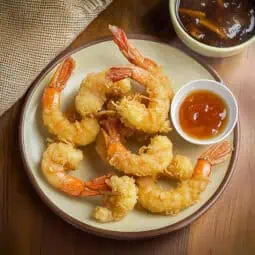
Camaron Rebosado (Crispy Battered Shrimp)
Equipment
- Deep heavy-bottomed pot or wok (kawa) for even heat distribution during frying
- Candy/oil thermometer ensures perfect oil temperature
- Spider strainer (salaan) for safely removing fried shrimp
- Wire rack allows excess oil to drip
- Mixing bowls separate bowls for marinade, batter, and coating
- Paper towels for draining excess oil
- Kitchen scissors (Gunting) for deveining shrimp
- Sharp knife (kutsilyo) for butterflying shrimp
Ingredients
For the Shrimp
- 1 pound 16-20 pieces large shrimp (sugpo/hipon)
- 1 teaspoon calamansi or lemon juice
- ½ teaspoon salt asin
- ¼ teaspoon ground black pepper paminta
For the Batter
- ½ cup all-purpose flour arina
- ½ cup cornstarch corn starch
- 1 teaspoon baking powder pampaalsa
- 1 teaspoon salt
- ½ teaspoon white pepper
- 1 large egg cold
- ½ cup ice-cold water
- 1 tablespoon sesame oil optional
For Coating
- ¼ cup cornstarch for dusting
For Frying
- 4 cups canola or vegetable oil
Instructions
- First, prepare your shrimp. Remove the heads but keep the tails on. Cut a line down the back of each shrimp and remove the dark vein. Make three small cuts on the belly side to prevent curling. Pat the shrimp completely dry with paper towels.
- Mix the cleaned shrimp with calamansi juice (or lemon), salt, and pepper in a bowl. Cover and refrigerate for 10 minutes.
- While the shrimp marinates, sift together flour, cornstarch, baking powder, salt, and white pepper in a large bowl. Put this dry mixture in the refrigerator for 30 minutes - cold ingredients are the secret to crispy coating.
- Heat your oil in a deep pot or wok. You'll need about 3 inches of oil, heated to 350°F. If you don't have a thermometer, test by dropping a small bit of batter - it should sizzle and float immediately.
- Take your flour mixture out of the fridge. In a separate bowl, mix the cold egg with ice-cold water. Pour this into your chilled flour mixture and stir gently just until combined. Don't worry about small lumps - they're good for crispiness.
- Put some cornstarch on a plate. Take each marinated shrimp, coat it in cornstarch, shake off the excess, then dip in your batter. Hold it by the tail and let extra batter drip off.
- Carefully place each battered shrimp in the hot oil. Don't crowd the pot - fry only 4-5 pieces at a time. Cook for 2-3 minutes until golden brown.
- Lift out the crispy shrimp with a strainer and place them on a wire rack, not paper towels - this keeps them crispy. Let the oil return to 350°F before cooking the next batch.
- Serve your Camaron Rebosado immediately while hot and crispy. Arrange on a platter with sweet and sour sauce, banana ketchup, or sweet chili sauce for dipping.
- Remember: these are best eaten right away while the coating is perfectly crispy and the shrimp is piping hot. If you need to keep them warm, place in a 200°F oven for no more than 30 minutes.
Tips from Lola's Kitchen
- Keep everything cold - refrigerate batter ingredients beforehand
- Use ice-cold water for the crispiest coating
- Don't overmix the batter - lumps are good!
- Pat shrimp very dry before coating
- Maintain oil temperature between batches
Nutrition
The Story Behind Camaron Rebosado
Camaron Rebosado stands as a testament to the Philippines' rich culinary heritage, where centuries of cultural influences have melded into uniquely Filipino flavors. While its name derives from Spanish—"camarón" meaning shrimp and "rebosado" meaning battered—this crispy shrimp dish actually traces its roots to Chinese cooking techniques that arrived with early traders and settlers in the Philippine archipelago. This fascinating fusion showcases how Filipino cuisine has masterfully adapted foreign influences while making them distinctly its own.
In the bustling streets of Manila's Binondo district, the world's oldest Chinatown, versions of this dish first gained popularity in Chinese restaurants during the early 20th century. The technique of coating seafood in a light, crispy batter closely resembles Chinese cooking methods, particularly those from the southern coastal regions where seafood preparation was an art form. Filipino cooks then adapted this method, incorporating local ingredients like calamansi and creating complementary dipping sauces that better suited the Filipino palate.
What sets Filipino Camaron Rebosado apart from similar Asian fried shrimp dishes is its distinctive batter. Unlike Japanese tempura's airy lightness or Chinese-style prawn's thicker coating, the Filipino version achieves a perfect middle ground—crispy enough to create that satisfying crunch, yet light enough to let the sweet, succulent flavor of the shrimp shine through. This unique balance has made it a mainstay at Filipino family gatherings, fiestas, and restaurants across the country.
Today, every region in the Philippines has its own take on Camaron Rebosado. In coastal areas like Bataan and Pangasinan, where fresh seafood is abundant, locals often prepare this dish using freshly caught shrimp, some as large as prawns. Meanwhile, in urban areas, innovative cooks have developed variations using different batters and dipping sauces, though the classic sweet and sour sauce remains the most beloved pairing. Whether served as pulutan (bar snacks), appetizers at formal gatherings, or as a main dish with steaming white rice, Camaron Rebosado continues to evolve while maintaining its cherished place in Filipino cuisine.
This enduring popularity has seen Camaron Rebosado transcend its Chinese-Spanish origins to become quintessentially Filipino, representing the adaptability and creativity that characterize Philippine cooking. From humble street food stalls to high-end Filipino restaurants worldwide, this dish tells the story of Filipino cuisine's ability to embrace influences while creating something uniquely its own.
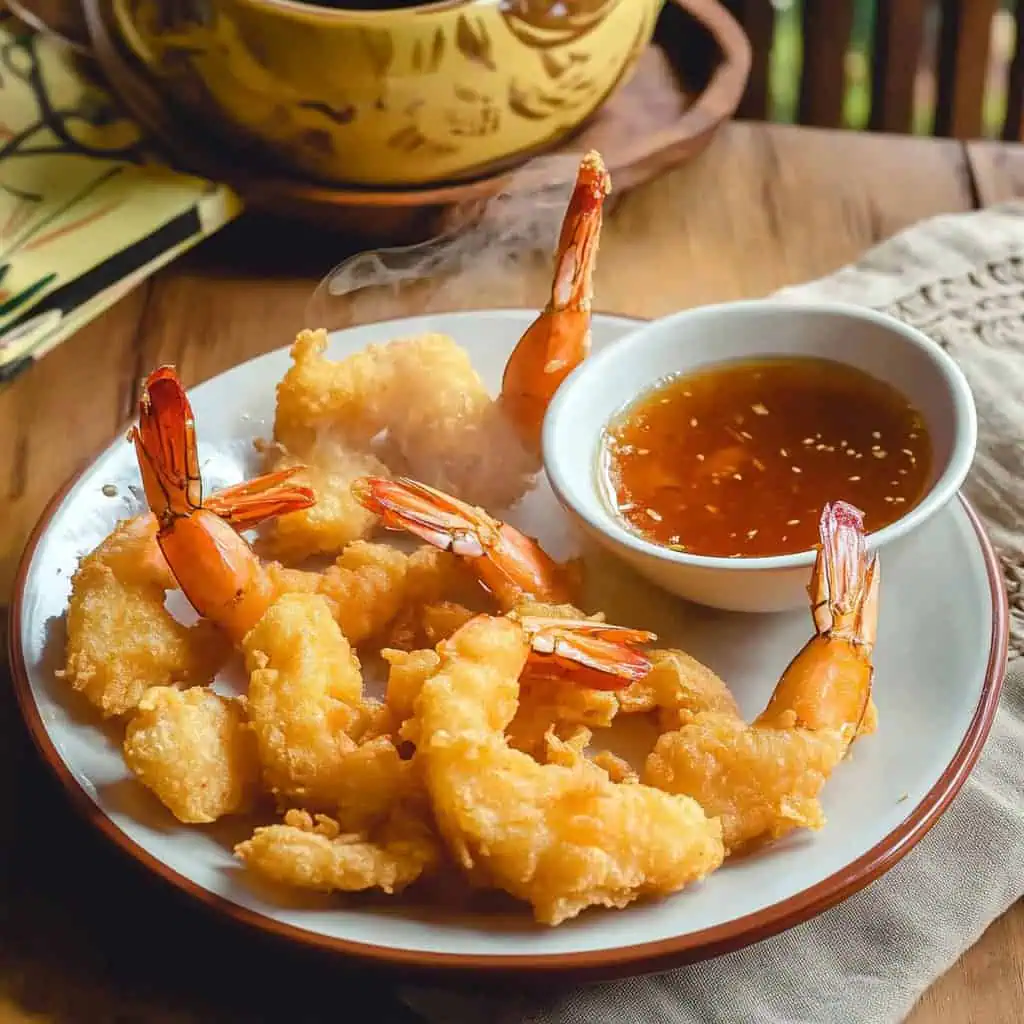









Comments
No Comments